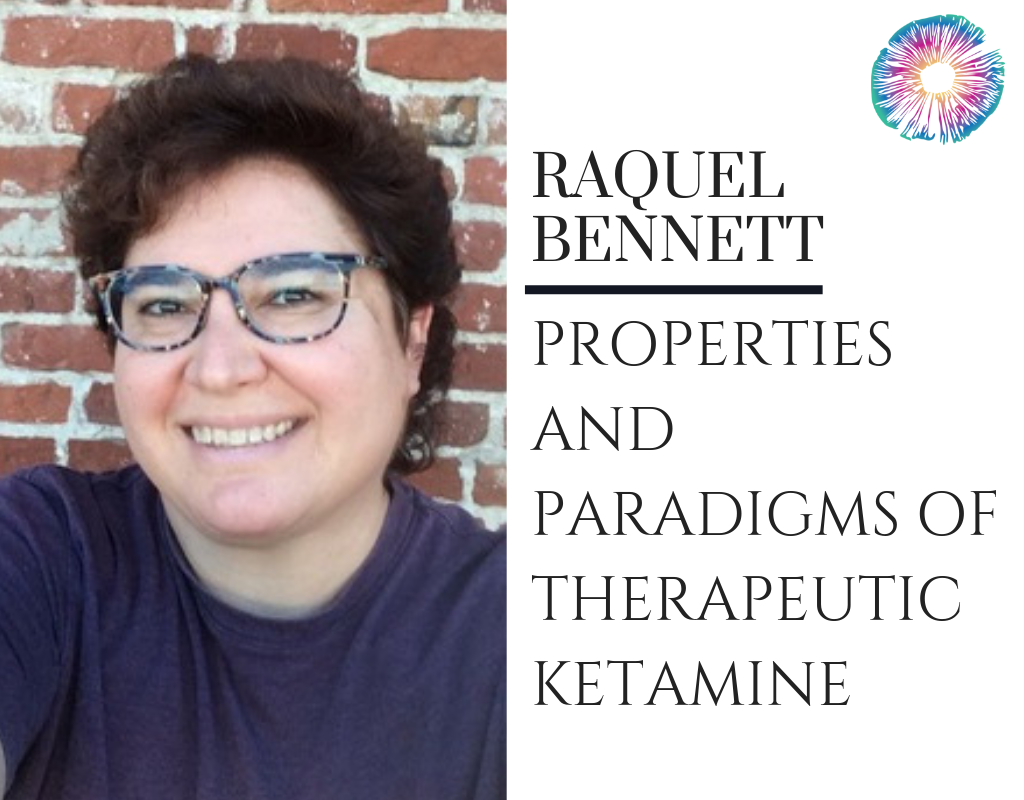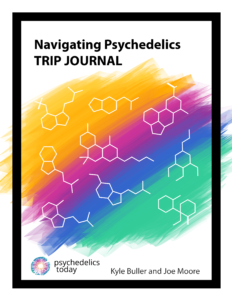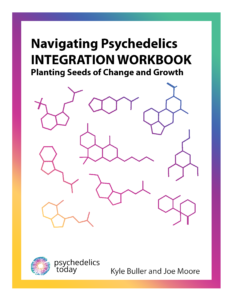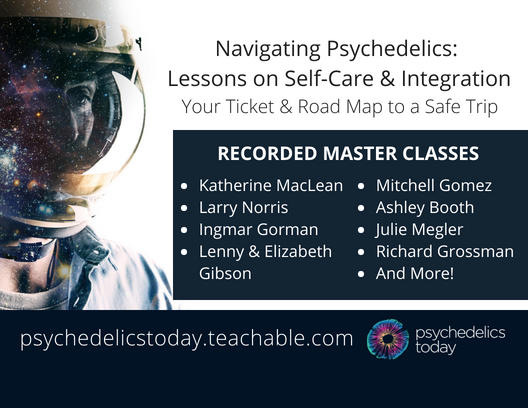
In this episode, Joe interviews Raquel Bennett, Psy.D. at Kriya Institute. In the show, they cover topics surrounding the properties and paradigms of therapeutic Ketamine use.
3 Key Points:
- The Kriya Institute is devoted to understanding the therapeutic properties of Ketamine. Raquel Bennett specializes in using Ketamine therapy for patients with severe treatment resistant disorders.
- There are three questions that should be used when determining if someone is fit for Ketamine therapy. Is it safe? Is it legal? Is it ethical?
- There are many different paradigms for Ketamine Therapy, but determining the best method for each individual patient is the goal.
Support the show
- Patreon
- Leave us a review on iTunes
- Share us with your friends – favorite podcast, etc
- Join our Facebook group – Psychedelics Today group – Find the others and create community.
Navigating Psychedelics
Trip Journal Integration Workbook


Show Notes
Kriya Institute
- The Kriya Institute deals with how to work with Ketamine specifically in Psychiatry and Psychotherapy
- Kriya provides clinical services to patients, training for other clinicians, and Kriya conference
- The conference is a big collaborative meeting
- Raquel is trying to create a patient assistance fund to make services more available to people
Ketamine
Ketamine isn’t addictive physically
It is possible to become psychologically addicted to Ketamine
Raquel thinks its a property of the person not of the object
It’s possible to become addicted to anything, shopping, sex, etc.
About Raquel
- She first encountered Ketamine in 2002 when she was suffering from severe depression
- She was seeing a therapist that took her to a psychedelic shaman where she took Ketamine
- From the way she felt after taking Ketamine, she wanted to know if it was replicable for other people
- She is interested in people with treatment resistant mood disorders, such as severe depression, unusual bipolar disorder and people living with active suicidal ideation
- She remembers her teachers (who gave her Ketamine) saying they don’t use it often, and don’t know if it will work
- They were not seeking an antidepressant effect, they were helping her to connect to the cosmos and the universe, to find out why she was having such severe depression
- The fact that it acted as a rapid-acting antidepressant was a surprise to them, and that’s what triggered her curiosity with it
- “Most of what I know of being a Ketamine provider, I learned from being a patient” – Raquel
Ketamine and Patents
- Johnson and Johnson just came out with a filtered Ketamine product that they patented
- $850 for 84mg of filtered Ketamine
- $1.59 for 100mg of generic Ketamine
- They are only providing it as a nasal spray
- Companies tried to make a new molecule, but they couldn’t
- Instead, they modified it, and filtered it, and then patented it (Esketamine)
Ketamine Treatment Paradigms
- There is a lot of disagreement on the route, the dose, the setting importance, etc
- This was the reason she created the Kriya conference, to share ideas, to find the best possible methods
- One way is to give it as a low dose infusion out of the anesthesiology model (0.5mg of Ketamine per kg of bodyweight in an infusion center)
- They aim to get enough ketamine in the patient’s body without the psychedelic effects
- They take the normal dose, divide it by 6, and space it out to avoid the psychedelic nature
- The patient is being forced into a passive role, they aren’t being called to heal themselves, they are just showing up for the medicine
- Raquel says that’s not all that there is to it, the medicine is only half of it
- Another paradigm for using Ketamine is facilitated Ketamine Psychotherapy
- In this way, the Ketamine is used as a lubricant for talk therapy
- We are using Ketamine to help people to talk about material that is too painful or too shameful to get to otherwise” – Raquel
- In this paradigm, the emphasis is on the therapy, not the Ketamine, the Ketamine is a lubricant and a tool
- In this way, the patient and the therapist are both participating 50%, the patient is not passive
- She says the psychedelic effects are to be avoided, or else the patient becomes too far out
- The third paradigm would be to induce mystical experience on purpose
- As a provider, it is believed that the visions are meaningful
- Only about 1 in 6 patients are actually a good candidate for psychedelic dosing
- The patient is willing to offer their body up as a vessel, and the messages they receive are from God
- The provider’s role is to make sure the journey is safe, and then help the patients to help construct meaning from what they saw, create actionable steps on how to change their lives
- Raquel says that all of these paradigms are helpful, different methods work for different patients
- That’s her job as a Ketamine Specialist, to determine which method is best for patients
- “This is where the direction of the field needs to go, being aware of the spectrum of the services available, and then matching the treatment to the patient. Individualized treatment.” – Raquel
Proper Use
- Is it safe? Is it legal? Is it ethical?
- Is it appropriate to give Ketamine Treatment to someone without a profound impairment or disorder?
- The literature supports the use of Ketamine for the following psychiatric or psychological disorders; major severe refractory depression, bipolar depression, physical pain with depression, recurrent suicidality and obsessive compulsive disorder
- Do the potential benefits verify the potential risks?
- Raquel doesn’t believe that making this experience available to everyone is the right way, her goal is to demonstrate that Ketamine is safe and useful for refractory problems
Group Administration
- They can work with 6 clients at a time
- It includes carefully selected individuals that all fit into the group
- This provides a much lower cost for patients
Ketamine Types
- There are 3 Types of Ketamine
- The molecules themselves are not flat, they are 3 dimensional and fold in space
- Some molecules are ‘right handed’ and others are ‘left handed’
- Right handed molecules are Arketamine and left handed are Esketamine
- Generic Ketamine is an even amount of Arketamine and Esketamine molecules
- What Johnson and Johnson did with Esketamine was patenting the filtration process of removing Arketamine from the Esketamine molecules
Kriya Institute Site
- Kriya Conference in November
- A list of providers working with therapeutic Ketamine
- A resource list of books and journey music
- A Contact option
Links
About Raquel Bennett

Dr. Bennett is a Post-Doctoral Fellow in Clinical Psychology (PSB 94022544), working under the supervision of Dr. Bravo. Dr. Bennett primarily works with people who are experiencing severe depression, who are on the bipolar spectrum, or who are contemplating suicide. She has been studying the therapeutic properties of ketamine since she first encountered it in 2002. In addition to her clinical work, Dr. Bennett’s practice has evolved to include consultation services for medical professionals who wish to add ketamine services to their offices. She also lectures frequently about therapeutic ketamine. Dr. Bennett is the Founder of KRIYA Institute and the Organizer of the KRIYA Conferences.



